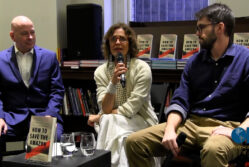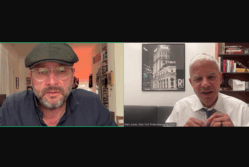Event Coverage Highlight

Researchers Discuss AP’s Coverage of Nazi Germany in ‘Newshawks of Berlin’
by Chad Bouchard
In the spring of 2016 a German historian, Harriet Scharnberg, published an academic paper alleging that AP ceded influence to Nazi propagandists over its German photo operation from the early days of Nazi power until Germany and the U.S. went to war against each other in 1941.
The article, published in the journal Studies in Contemporary History under the title “The Nuts and Bolts of Propaganda,” landed what author and AP investigative journalist Randy Herschaft called “a bombshell that hit the AP offices and startled its staff.”
Herschaft spoke to the OPC during an event on March 13, along with editor and collaborator Ann Cooper, to discuss the ensuing investigation and resulting book, Newshawks in Berlin: The Associated Press and Nazi Germany.
Herschaft said in the wake of Scharnberg’s revelations John Daniszewski, a longtime OPC member and President of the OPC Foundation who serves as the vice president and editor at large for standards of the AP, felt it was important for the agency to investigate its role in Germany during the war.
Herschaft teamed up with Larry Heinzerling, who served as reporter, foreign correspondent, and news executive during his forty-one-year career at the AP. Cooper, Heinzerling’s wife, worked with Herschaft to complete the book following Heinzerling’s death in 2021.
Herschaft said Scharnberg wrote that the AP ceded influence to Nazi propagandists in its German photo service from 1933 to 1941. She also noted that the Nazis misused AP photos to further the regime’s virulent antisemitism and revealed for the first time AP’s use of photos from a dedicated Nazi photographer, Franz Roth.
He and Heinzerling pored over formerly classified government records, diary entries and correspondence, and reviewed countless published articles and images to analyze what the AP covered and what was omitted. The agency’s own official histories did not give a complete picture, so they delved into an extensive repository of journalist papers housed at the Wisconsin Historical Society, where three of the AP’s Berlin “newshawks” had donated their personal collections. Also at the archive were papers from Byron Price, a journalist, bureau chief and executive editor and editor with the AP from 1912 to 1941 who served as director of the U.S. Office of Censorship from 1941 to 1945. The collection also included included the voluminous papers from Louis P. Lochner, AP’s Berlin bureau chief from 1924 to 1941. Lochner’s extensive communications with Kent Cooper, the AP’s general manager at the time, is an important complement to the collection. Lochner served as president of the OPC in the early 1950s.
“His reporting was criticized by some at AP,” Herschaft said, because he hadn’t been thoroughly trained in the AP’s system. “He was accused by others of being enthusiastic and reporting the German propaganda line.”
But Herschaft said Lochner predicted in 1932 that the Nazis would be a “plague for the Jews,” reporting thoroughly on anti-Semitic incidents, and in 1939 reported on Hitler’s “liquidation” campaigns against Jewish communities and mass deportations of two million jews to Eastern Europe in 1941.
Cooper said AP coverage of the era was crucial, with about 1,200 American newspapers subscribing to the service, potentially reaching tens of millions of subscribers per day.
“Nobody was as important as AP. It’s kind of hard to grasp now just how important it was. There’s no internet, there’s no TV in the 30s or through the war. Radio is in its infancy. So, in America, where were you getting your news? You were getting it from your hometown newspaper, and odds were very good that it was an AP subscriber.”
She added that each paper made its own decisions about whether to use an AP story, where to place it, and how much of a given article to print.
“There were two levels of gatekeepers – the AP editors, and then the editors at the subscriber paper,” she said. “How one individual story was played could look very different across the country.”
She cited as an example story from the AP Berlin bureau in late 1942 saying the U.S. State Department had confirmed the Nazis had killed two million Jews, and that Hitler planned to carry out a complete annihilation of Jews in Germany by the end of that year. She said the story ran on page one in several places but was on page six of The Washington Post and only a shortened version ran on page ten of The New York Times, without the information about Hitler’s plans.
Cooper and Herschaft talked about the strict system of censorship that the Nazis imposed and how the reporters had to walk a tightrope to get information past censors, with some tangible repercussions in the form of bans for reporting the Nazis did not like, which then caused a “chilling effect” of self-censorship. Photos and radio scripts had to be submitted for approval.
Herschaft shared some of the AP photos taken at the time that were preserved in the AP’s library in London, which are included in the book, and discussed images that were cropped or selected to satisfy censors, and some that were not used for fear that journalists could be expelled. The AP’s photo operation, separate from the news bureau, was a German-registered company subject to German laws, including antisemitic policies.
“One of the most daunting challenges for any journalist is to report from a totalitarian society,” said moderator Andrew Nagorski, a journalist and author who spent more than three decades as a foreign correspondent and editor for Newsweek. In 1982, the Soviet government, angry about Nagorski’s enterprise reporting, expelled him from the country. “And one of the hardest assignments for journalists is then to examine the record of their own journalistic organization in that context.”
Newshawks In Berlin is available for purchase here.
Click the window below to watch a playlist of video clips from the program.



